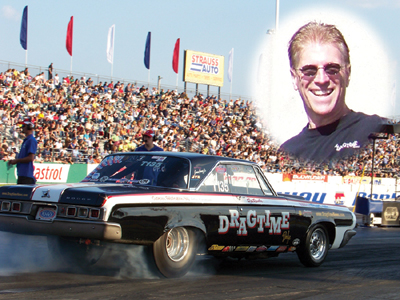| (Article
begins on the Bracket Racing 101 page HERE)
 Whether
you race on a .400 or .500 Pro or Sportsman (full blinkdown)
tree, reaction time is critical to being successful at dial-in
or index racing, yet there are racers who don’t really
know what it is. Sure, they know it’s a number on
the time slip that describes how closely the car left the
starting line in relation to the green light coming on,
but they’re not really sure what comprises it. Whether
you race on a .400 or .500 Pro or Sportsman (full blinkdown)
tree, reaction time is critical to being successful at dial-in
or index racing, yet there are racers who don’t really
know what it is. Sure, they know it’s a number on
the time slip that describes how closely the car left the
starting line in relation to the green light coming on,
but they’re not really sure what comprises it.
Reaction
time is made up of two primary components: the driver’s
reaction to the Christmas tree, and the car’s reaction
to the driver hitting the throttle. How the car is staged
is also a factor, but we’ll leave that out of this
discussion for simplicity. Let’s look at the first
component: Driver Reaction Time. Knowing your own Driver
Reaction Time is the first step in mastering the overall
reaction time equation. Skilled and knowledgeable racers
have determined theirs, and it’s really quite simple
to figure out. You will need a practice tree to do so; there
are many available on the market. I suggest a table-top
unit, although a hand-held or full-size will certainly do.
Practice
trees have different settings to account for the different
types of Christmas tree settings; they also have rollout
settings to approximate the second component of reaction
time, Vehicle Reaction Time, as well as delay settings for
delay-box racers. The first step is to set up the practice
tree to determine your Driver Reaction Time. Since many
of us normally race on a .500 Sportsman (full blinkdown)
tree, that’s the tree we’ll use for this discussion.
First, you must set the tree’s delay and rollout to
zero (.000). Next, set the tree to .500 Pro (that’s
not a typo: .500 Pro tree). Set the tree up for single-lane
operation, or if it’s two-lane, remove any handicap
start from either lane: you want both lanes to light up
at the same time.
Now
it’s time to start hitting the tree. Hold the trigger
button, pre-stage and stage your lane, and let go of the
button as quickly as you can at the first hint of amber
flash. Do this five times to get comfortable, then for real
another ten or more times and jot down the resulting reaction
times. Because you’ve removed all rollout, you will
be red every time. That’s OK; you’re just collecting
data. Add up the ten or more hits, and then divide by the
number of hits to find your average. Mine were -.348, -.348,
-.328, -.351, -.351, -.354, -.358, -.352, -.359, and -.337;
the average is -.349. Subtract this number from .500 to
determine your own Driver Reaction Time. In this case, my
average Driver Reaction Time is .151. You now know half
of the overall reaction time equation. From here it’s
time to set the tree up for green lights. Let’s say
you want a target green light of .010: simply add a sufficient
rollout to your average Driver Reaction Time. In this case
it would be .151 + .359 = .510, which is a .010 green light.
Still using a .500 Pro tree, do another ten hits. With the
addition of the rollout, you should now be hovering around
that .010 reaction time.
Now
the fun begins. Set the Tree to .500 Sportsman so that it’s
a full blinkdown, and focus your eyes and brain solely on
the bottom amber; your world now revolves only around that
bulb. Take another ten or more hits, and jot down the resulting
reaction times. If you’re now coming up with a bunch
of red lights, then you’re anticipating and jumping
the last amber. If you’re now coming up .030s or later,
then you’re sitting on the amber. It’s important
to remember that when racing on a .500 Sportsman tree, the
first and second ambers are there only to distract you.
You must try to ignore them so that your reaction time is
the same regardless of Pro tree or Sportsman tree.
Next
time, we’ll take a closer look at the second half
of the equation, Vehicle Reaction Time. Thanks for reading.
|



